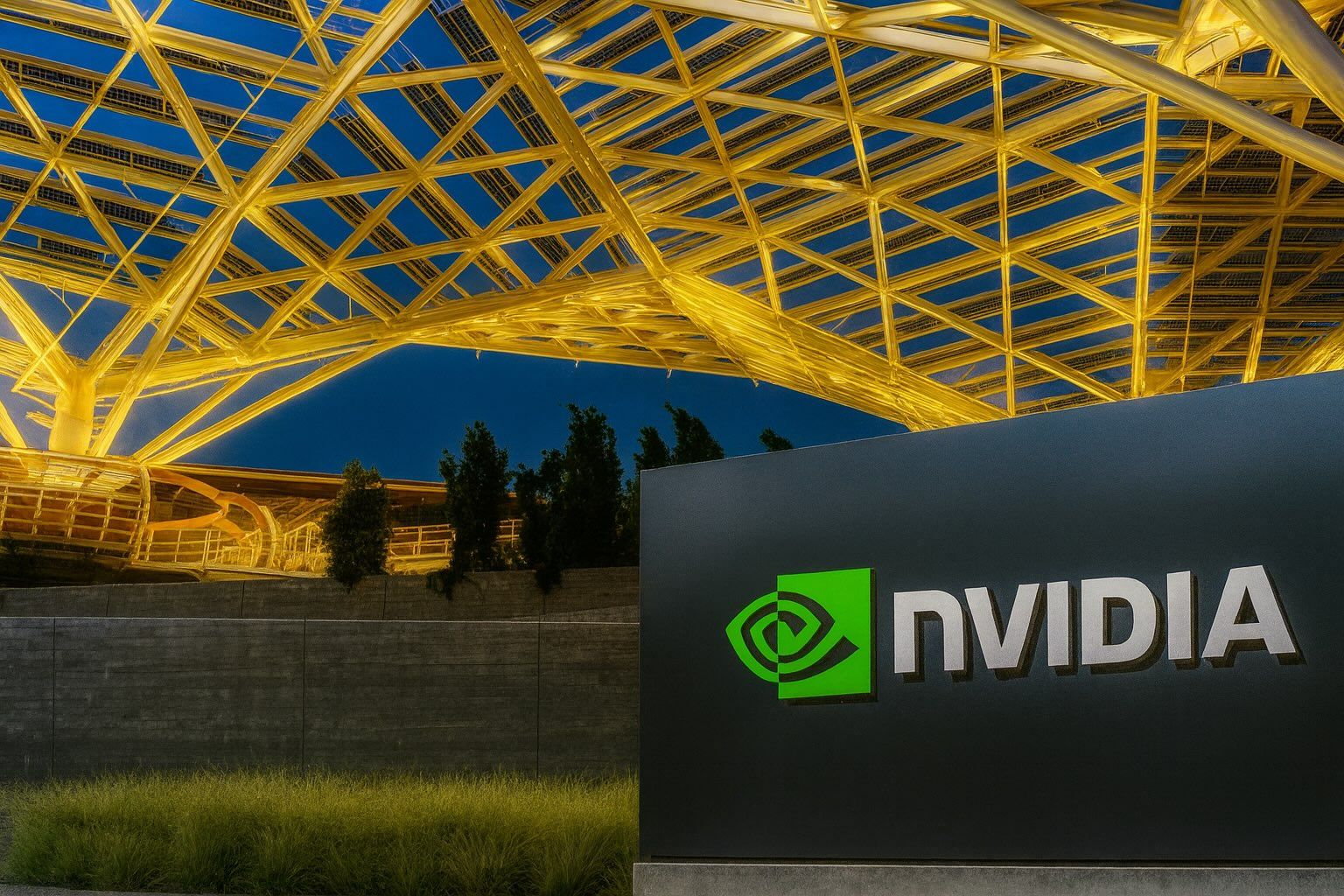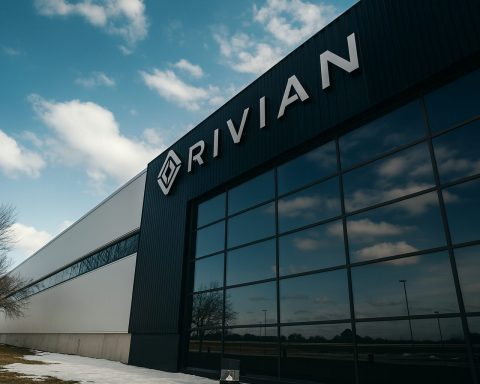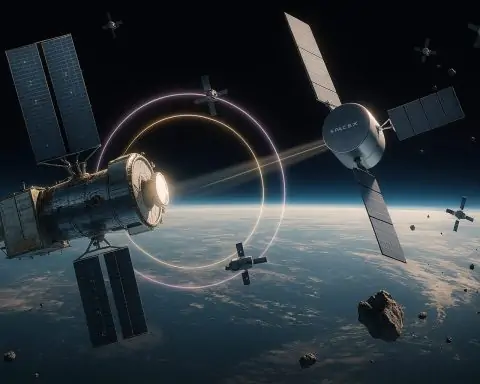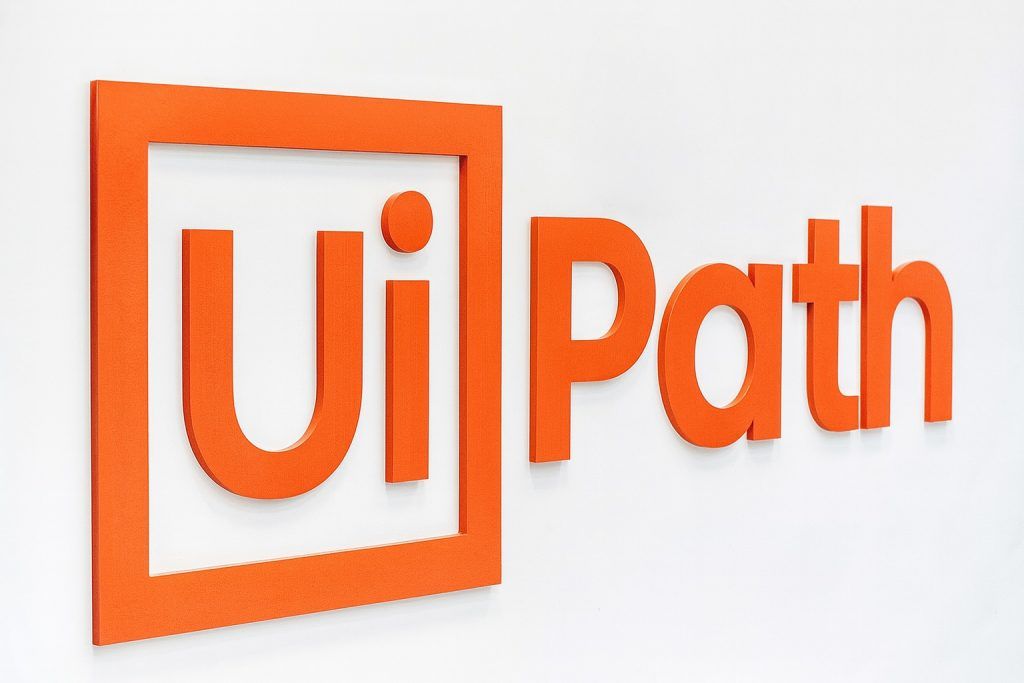- All-Time High Valuation: Nvidia’s stock (NVDA) skyrocketed to new records in early October 2025 – trading around $187–$190 per share – briefly valuing the company above a $4 trillion market cap, thereby surpassing Apple as the world’s most valuable public company [1]. The stock has roughly tripled in value over the past year amid frenzied demand for artificial intelligence (AI) plays, climbing about 40% year-to-date in 2025 [2].
- Blowout Financial Performance: Booming AI chip demand fueled a 56% year-on-year jump in quarterly revenue to $46.7 billion, with hefty 72% gross margins [3]. Nvidia’s latest earnings (fiscal Q2 2026) smashed expectations and led management to raise next-quarter sales guidance to ~$54 billion, signaling that the AI boom is still accelerating [4]. CEO Jensen Huang lauded the company’s new “Blackwell” AI GPUs for delivering an “exceptional generational leap” and noted demand is “extraordinary” [5].
- Massive AI Partnerships: Nvidia is striking huge deals to cement its leadership. In late September, it unveiled a $100 billion partnership with OpenAI to build next-gen AI supercomputers (deploying 10 GW of Nvidia hardware) [6]. Under this unique arrangement, Nvidia will invest in OpenAI and supply it with millions of GPUs starting in 2026, underscoring Nvidia’s central role in the AI revolution. The company also announced a $5 billion strategic stake in Intel (~4% ownership) to co-develop data-center and PC chips [7] – a surprise alliance that sent Intel’s stock soaring over 20% [8]. Even China’s tech giant Alibaba revealed it’s partnering with Nvidia to integrate Nvidia’s AI tools into Alibaba’s cloud platform, news that boosted Alibaba’s shares ~10% [9].
- Rivals Strike Back – AMD’s Big Win: Nvidia’s dominance is spurring competitors to act. On Oct 6, AMDannounced a major deal to supply OpenAI with hundreds of thousands of AI chips (≈6 gigawatts of GPUs) over several years, giving OpenAI an option to take up to a 10% stake in AMD [10] [11]. AMD’s stock surged over 30% on the news, while Nvidia’s slipped ~1% as investors weighed this competitive twist [12]. The partnership could add >$100 billion to AMD’s revenue over four years [13] and validates AMD’s new MI300-series AI accelerators. However, analysts note Nvidia still holds a 90%+ share of the AI accelerator market, thanks to its powerful hardware and CUDA software ecosystem that rivals struggle to match [14]. In other words, AMD’s win is significant but unlikely to dent Nvidia’s dominance near-term [15].
- Wall Street’s Bullish Outlook: Market sentiment around Nvidia remains euphoric despite its high valuation. Roughly 38 out of 45 analysts rate NVDA a “Buy,” with an average 12-month price target around $212 – implying ~15–20% upside from current levels [16]. Big banks have repeatedly hiked their targets after Nvidia’s blowout results (e.g. Citigroup to $210, Barclays to $240) [17]. Some ultra-bulls have even floated a path for Nvidia to reach a $10 trillion valuation in coming years, given its AI leadership [18]. “Nvidia could easily command 40% of the total AI infrastructure spend,” one analyst argued, suggesting enormous runway ahead. But not everyone is euphoric – even fans warn the stock’s rich valuation (around 50× earnings) is “baking in” years of perfection [19]. Veteran tech investor James Anderson likened the AI frenzy to the dot-com bubble, saying Nvidia-mania “reminded me of 1999” [20]. Advisor Oliver Pursche similarly cautioned that “valuations are getting stretched… [investors are] ignoring potential headwinds” [21]. In short, the bulls vastly outnumber bears, but expectations are sky-high.
- Nvidia vs. Competitors: Nvidia’s market position towers over chip peers. At ~$4.5 trillion, its market cap is nearly 18× the size of AMD (~$260 billion) and 30× Intel (~$150 billion) [22]. Even Broadcom (around $1.3–$1.5 trillion after recent acquisitions) is only one-third of Nvidia’s value [23]. Revenue-wise, Nvidia’s annual sales (~$165 billion) dwarf AMD’s ~$30 billion or Intel’s ~$53 billion [24]. AMD – Nvidia’s closest GPU rival – has been growing its data-center business (EPYC server CPUs and new MI300/MI350 AI GPUs), and its OpenAI deal is a big boost signaling large customers want a second source beyond Nvidia [25]. Intel, meanwhile, has struggled with flat sales and is restructuring; Nvidia’s $5B investment just made it Intel’s third-largest shareholder, and the two will collaborate on certain chips (though notably not on Intel’s foundry business) [26]. This partnership, alongside Intel’s other tie-ups (e.g. with TSMC and SoftBank), reflects the strange new alliances forming as everyone races to meet AI demand [27]. Qualcomm, traditionally focused on mobile and 5G chips, is now pivoting into automotive and AI processing to diversify as phone growth slows [28]. And Broadcom, now a $1½ trillion behemoth, is benefiting from networking gear and custom AI silicon – its CEO Hock Tan even forecast “ten consecutive quarters” of growth driven by AI demand [29]. Each player has strengths, but Nvidia’s end-to-end platform – from cutting-edge silicon to its ubiquitous CUDA software and developer ecosystem – gives it a wide moat that others are only slowly chipping away at [30].
- Geopolitics and Risks: Not everything is smooth sailing. U.S.–China tech tensions pose a real risk. U.S. export controls bar Nvidia from selling its top-tier AI GPUs (like the H100) to China, cutting off what had been a huge market [31]. Nvidia even took an inventory write-down on specialized China-only chips after new restrictions and has excluded any potential China sales from its forecasts [32]. Beijing has pushed back too – Chinese regulators reportedly banned domestic tech firms from purchasing Nvidia chips in response to U.S. curbs [33], and state media have raised (disputed) security concerns about Nvidia products [34]. Meanwhile, U.S. allies are clamoring for Nvidia’s AI technology. A multibillion-dollar deal to supply Nvidia chips to the UAE, announced in spring 2025, was stuck in limbo for months awaiting U.S. approval – frustrating Jensen Huang [35] – but in October the Commerce Department finally approved billions in Nvidia chip exports to the UAE under a bilateral AI partnership [36]. (The agreement allows the Emirates to import up to 500,000 of Nvidia’s most advanced AI chips per year starting in 2025 [37].) These geopolitical cross-currents underscore how strategic Nvidia’s chips have become – they are now seen as critical assets in a global tech race. Legal battles are emerging too. In November, Nvidia faces a jury trial over allegations that a former employee stole self-driving tech secrets from a prior employer and brought them to Nvidia [38]. Nvidia denies wrongdoing, but the case (focused on automotive AI software) shows how the company’s rapid expansion can attract intellectual-property disputes and regulatory scrutiny. In fact, some observers warn Nvidia’s $100B OpenAI alliance – pairing the top AI chip supplier with the leading AI software firm – could draw antitrust questions about concentration of AI power [39]. Regulators worldwide are undoubtedly watching the AI chip sector closely given its importance.
Record Stock Highs on Surging AI Demand
Nvidia’s stock has been on a historic tear in 2025, buoyed by insatiable demand for its AI chips. The share price hit an all-time high in early October, briefly trading around $189 – a level that catapulted Nvidia’s market capitalization above $4 trillion [40]. That astounding valuation vaulted Nvidia past Apple and Microsoft to become the world’s most valuable company, at least momentarily. It marks an almost three-fold increase in Nvidia’s market cap within a year [41], reflecting Wall Street’s fervor for anything AI-related. Indeed, Nvidia – often called the “AI superpower” of semiconductors – has seen its stock climb roughly 40% year-to-date in 2025 [42] (on top of a massive rally in 2024). This rally has been so steep that some veteran investors are reminded of the late-1990s dot-com mania. “The frenzy [around Nvidia] reminded me of 1999,” said James Anderson, a noted tech fund manager, cautioning that current exuberance echoes the dot-com bubble [43].
What’s driving the hype? In short, explosive growth and outsized profits. The AI boom is translating into staggering financial results for Nvidia, far above anything the company has seen before. In its most recent quarter (FY2026 Q2, reported in late August), Nvidia’s revenue hit $46.7 billion, up 56% from the same period a year prior [44]. For context, just two years ago Nvidia’s quarterly sales were around $7 billion; now it’s earning that many times over per month. Even more striking, gross profit margins ballooned to roughly 72% [45] – meaning Nvidia is capturing extraordinary profit on each sale thanks to the premium pricing and scarcity of its AI chips. This combination of volume and margins led to a 59% jump in net income year-on-year [46], an almost unheard-of profit growth rate for a company already of this size.
Nvidia’s CEO, Jensen Huang, attributes the performance to runaway demand for the company’s latest AI silicon platform, code-named Blackwell. “Blackwell is the AI platform the world has been waiting for, delivering an exceptional generational leap … and demand is extraordinary,” Huang said in the earnings release [47]. In a CNBC interview around the same time, Huang noted that in the past six months, “demand … has gone up substantially”, emphasizing that the AI boom still feels like it’s in early stages [48]. In other words, despite Nvidia’s sales already being up over 5× from two years ago, Huang believes the world’s hunger for AI compute power is just beginning.
Investors seem to agree. Nvidia’s blowout results prompted the company to issue record-high guidance for the upcoming quarter: it forecast $54 billion in revenue for Q3 (Nov 2025), which would be another big sequential jump [49]. Such rosy guidance stunned analysts, who have been repeatedly raising their estimates and price targets on Nvidia. For example, Citi recently boosted its 12-month target to $210, and Barclays to $240 [50]. In fact, of the 45 Wall Street analysts covering NVDA, about 38 now rate it a Buy [51] – an overwhelming consensus that Nvidia will continue to outperform. The average price target is ~$212 [52], implying that even after this year’s enormous rally, analysts see more upside ahead.
At the same time, cooler heads warn that at some point the numbers have to normalize. With Nvidia trading around 50 times earnings and over 30× forward earnings [53], the stock’s valuation is baking in years of high growth. “Valuations are getting stretched… markets [are] ignoring potential headwinds,” as advisor Oliver Pursche observed of the current sentiment [54]. The bull case is that Nvidia is not just another tech company – it’s essentially the arms dealer of the AI revolution, selling the shovels in a gold rush – and thus could sustain high growth for an extended period. The bear case is that even great companies can stumble or see growth slow, and when expectations are this elevated, any hiccup could send the stock reeling. For now, though, Nvidia’s stock momentum and financial performance appear to validate the bulls. The company’s ability to repeatedly “beat and raise” (beat earnings expectations and raise guidance) has reinforced its status as the marquee AI investment.
AI Mega-Deals: OpenAI Partnership, Intel Stake, and More
To solidify its dominance in the AI era, Nvidia has been on a deal-making spree – forging blockbuster partnerships and investments that grab headlines. The most jaw-dropping is Nvidia’s new alliance with OpenAI, the high-profile creator of ChatGPT. In late September 2025, Nvidia announced it will invest up to $100 billion in OpenAI and become its core supplier of AI hardware [55]. The deal, described by Jensen Huang as “the biggest AI infrastructure project in history,” will see OpenAI deploy at least 10 gigawatts of Nvidia’s cutting-edge systems – roughly 4–5 million GPUs – across its data centers [56] [57]. Nvidia will progressively fund the build-out, providing capital as each gigawatt of capacity comes online [58] [59], and OpenAI will in turn use that money to buy Nvidia’s own chips. In effect, Nvidia is financing its top customer to massively scale using Nvidia hardware – a bold strategy some analysts dub “circular financing” [60].
Both sides are exuberant about the partnership. “Everything starts with compute,” OpenAI CEO Sam Altman said, explaining that vast computing power is the fuel for AI breakthroughs [61]. Altman noted “there’s no partner but NVIDIA that can do this at this kind of scale, at this kind of speed”, underscoring Nvidia’s unique capacity to deliver so many advanced chips so fast [62]. For his part, Huang emphasized that OpenAI and Nvidia have worked together for nearly a decade (Nvidia provided the first GPUs for OpenAI in 2016) and that this new deal is “a billion times more compute” than those early efforts [63]. The arrangement gives Nvidia a financial stake in OpenAI’s success while virtually locking OpenAI into Nvidia’s platform for the foreseeable future. It’s an empire-building move that cements Nvidia’s role at the heart of the AI explosion – though it has not escaped criticism (more on that later).
Nvidia hasn’t stopped there. In another dramatic turn, Nvidia surprised the industry by taking a $5 billion stake in Intel, the venerable chipmaker that had long been one of Nvidia’s rivals [64]. Announced in mid-September, this investment makes Nvidia one of Intel’s largest shareholders (approximately a 4% stake) [65]. The two companies plan to jointly develop new chips for PCs and data centers, marrying Nvidia’s AI accelerators with Intel’s CPU and packaging technology [66]. Notably, the partnership excludes Intel’s foundry business – Nvidia will continue relying on TSMC and others for manufacturing its own GPUs – but Intel will supply certain chips and advanced packaging for hybrid Nvidia-Intel products [67] [68]. This collaboration is a lifeline for Intel, which has struggled to regain its footing and was even forced to give a 10% stake to the U.S. government as part of a rescue plan [69]. Nvidia’s backing instantly boosted confidence in Intel’s future: Intel’s stock jumped 23% on the news [70]. “This is a massive game-changer for Intel and effectively resets its position… into a cog in future AI infrastructure,” said Gadjo Sevilla, an AI analyst, about Nvidia’s vote of confidence [71]. Some see it as Nvidia hedging its bets by keeping Intel (a potential manufacturing partner) afloat, while others speculate it could be a step towards a deeper integration or even a future merger. As one investment CEO put it, “This may be the first step of an acquisition or breakup of [Intel] among U.S. chip makers”, though she noted Intel might remain just a “shadow of its former self” that survives with help [72].
Beyond OpenAI and Intel, Nvidia has inked several other noteworthy deals in recent weeks:
- It quietly took a 7% stake in CoreWeave, a fast-growing AI cloud provider, and in September signed a $6.3 billion agreement to essentially guarantee CoreWeave’s capacity through 2032 [73]. Nvidia agreed to buy any unsold cloud GPU capacity from CoreWeave, ensuring the startup can invest in more Nvidia hardware – yet another example of Nvidia financing the AI ecosystem (and indirectly supporting its own chip sales) [74].
- Nvidia participated in a $1.1 billion funding round for NScale, a UK-based data center builder, investing about $700 million alongside partners like Dell and Nokia [75]. This ties into a government-backed push to build AI infrastructure in the UK, where Nvidia is also deploying 120,000 GPUs as part of a UK–US tech partnership [76] [77].
- The company spent over $900 million to acquire the team and technology of Enfabrica, a networking startup, to bolster its data-center networking capabilities [78]. Networking is crucial for scaling AI clusters, and Nvidia (which already owns Mellanox/InfiniBand) is shoring up any gaps in its portfolio.
- As mentioned earlier, Alibaba Group in China announced it will integrate Nvidia’s AI solutions into Alibaba Cloud, in areas like cloud services and enterprise AI offerings [79]. While financial terms were not detailed, this is strategically important as Alibaba’s cloud is a major platform in Asia. The partnership signals that despite U.S.–China tensions, Chinese tech firms still want Nvidia’s state-of-the-art AI tech (if they can get it).
Cumulatively, these deals portray Nvidia as not just selling chips, but actively investing in its customers and partners to spur AI adoption. It’s a virtuous cycle: by funding AI startups, cloud providers, and key customers, Nvidia helps them build more data centers stocked with Nvidia hardware – which then feeds back into Nvidia’s own growth. The risk, of course, is that Nvidia is shouldering a lot of the upfront cost (as seen with the OpenAI and CoreWeave financing arrangements). But for now, each announced partnership has only stoked enthusiasm. Nvidia’s shares often pop higher on these news drops, as investors interpret them as the company extending its lead and creating de facto alliances that competitors will struggle to crack.
One illustrative example is Oracle’s “Stargate” project – a $500 billion plan (with backing from Oracle, Microsoft, OpenAI, and SoftBank) to build massive AI superclouds around the world [80]. Oracle’s stock surged on its involvement, and Nvidia – though not an official partner on Stargate – stands to indirectly benefit since OpenAI and others will likely fill those data centers with Nvidia chips. In another case, Tesla recently inked a $16.5 billion deal with Samsung for advanced chips [81], and Meta struck a $14 billion GPU deal with CoreWeave [82]. These moves underscore that we’re in an AI arms race across the tech landscape, and Nvidia is positioning itself at nearly every major node of the emerging ecosystem.
Rivalry Heats Up: AMD, Intel, Qualcomm and Others
With Nvidia’s dominance in AI computing so pronounced, competitors are scrambling to gain ground. The biggest challenger is AMD (Advanced Micro Devices), which in early October scored its own coup with OpenAI. AMD’s multi-year agreement to supply 6 GW of AI accelerators to OpenAI – beginning in 2026 with its forthcoming MI450 chips – was hailed as “transformative… for the dynamics of the industry” by AMD’s data-center chief Forrest Norrod [83]. Under the deal, OpenAI not only commits to buying hundreds of thousands of AMD GPUs, but also received a warrant to purchase up to 10% of AMD’s stock at $0.01 per share (a virtually free stake) if certain milestones are met [84]. Those milestones include successful chip deliveries and AMD stock price targets up to $600 [85]. This structure gives OpenAI a vested interest in AMD’s success – a stark contrast to the Nvidia deal, where OpenAI doesn’t gain equity in Nvidia [86].
The market reaction to AMD’s news was dramatic: AMD shares rocketed +34% in one day on Oct 6, their biggest jump in nearly a decade [87], instantly adding ~$80 billion to AMD’s market cap [88]. Clearly, investors saw this as a watershed moment validating AMD’s AI chips. “AMD has really trailed Nvidia for quite some time. So I think [this deal] helps validate their technology,” said Leah Bennett, a chief investment strategist, noting that AMD’s MI300-series GPUs (and upcoming MI400 series) are finally gaining traction [89]. Importantly, analysts generally do not expect AMD’s win to meaningfully undermine Nvidia’s leadership in the short run [90]. Demand for AI hardware is so high that Nvidia is selling every H100 and A100 chip it can produce – and still has backorders – so OpenAI’s move to diversify suppliers is seen as expanding capacity rather than taking share from Nvidia [91]. As one Reuters column put it, Nvidia’s customers “need both Nvidia and AMD” to secure enough chips for their AI ambitions [92]. Still, longer term, AMD’s foothold could grow. The OpenAI partnership is expected to generate “tens of billions” in annual revenue for AMD once fully ramped [93], and it signals to other hyperscalers that AMD is a viable second source for high-end AI silicon [94]. In a sense, Nvidia’s own success – and occasional supply constraints – are creating an opening for AMD to play a complementary role.
Intel, another long-time rival, has taken a different approach by effectively partnering with Nvidia (as described above). After years of losing ground in both CPUs and failing to break into GPUs, Intel is now under new leadership and reorienting itself around serving the AI market. Nvidia’s $5 billion investment gives Intel a much-needed vote of confidence and cash infusion (on top of U.S. government and SoftBank investments) [95] [96]. Under CEO Lip-Bu Tan, Intel will co-develop custom central processors that pair with Nvidia’s GPUs for AI systems [97]. The idea is to use a proprietary Nvidia technology (likely NVLink/C2C) to let Intel CPUs and Nvidia GPUs communicate at ultra-high speeds inside servers [98]. This would effectively put Intel inside every Nvidia AI supercomputer as the CPU backbone – a role that AMD’s CPUs currently often fill. If successful, it’s a win-win: Nvidia gets tailor-made CPUs to complement its GPUs (potentially reducing bottlenecks), and Intel finds a new market for its chips in advanced AI infrastructure. Some analysts framed it as Nvidia throwing a lifeline to a “laggard” that might one day become an acquisition; others saw it as Nvidia hedging against reliance on TSMC by cozying up to an American manufacturer [99] [100]. Either way, Intel now has the backing of the world’s most valuable chip company, and that poses a new kind of challenge to others like AMD (which competes with Intel on CPUs and with Nvidia on GPUs). As portfolio manager David Wagner noted, AMD has been gaining PC market share, “but this [Intel-Nvidia deal] will help Nvidia out against its closest domestic peers” – while the bigger long-term risk might actually be to TSMC, since Nvidia could eventually shift some production to Intel if the partnership flourishes [101] [102].
Meanwhile, Qualcomm – known for smartphone processors and wireless chips – is also striving to stay relevant in the AI age. Qualcomm has been integrating AI acceleration into its mobile Snapdragon chips and recently touts its AI capabilities for on-device applications (like AI features in phones and PCs). More ambitiously, Qualcomm is pushing into automotive AI (for self-driving and smart cockpit systems) and edge AI for IoT and data centers [103]. In 2025, Qualcomm unveiled new AI chips for cars and hinted at server-class AI accelerators in development, aiming to leverage its power-efficient chip design expertise. However, Qualcomm’s efforts are still in relatively early stages and the company’s market cap (~$120 billion) and R&D budget are far below the likes of Nvidia, Google, or even AMD. Qualcomm’s strategy seems to be focusing on niches where it can compete – such as AI at the edge or specialized domains – rather than taking Nvidia head-on in cloud data centers. It’s also partnering with firms like Meta (which used Qualcomm AI hardware in some recent test deployments) and investing in AI software startups. Time will tell if Qualcomm can grow into a notable AI chip player; for now, it remains a smaller competitor pivoting to catch the AI wave.
It’s worth mentioning other players as well. Broadcom, for example, has become a significant supplier in the AI arena through its custom chips and networking gear. Broadcom builds AI-specific ASICs (application-specific chips) for large clients (Google has reportedly used Broadcom to help design its TPU AI chips), and Broadcom’s CEO Hock Tan has been extremely bullish, stating that AI is driving a new upcycle in his business. In fact, Tan confidently predicted “ten consecutive quarters” of growth ahead thanks to AI demand [104]. Broadcom’s recent acquisition of VMware also positions it in AI-enabled software and data centers. Then there are cloud giants like Google (with its TPU AI accelerators) and Amazon (with AWS Inferentia and Trainium chips) which design in-house chips for their clouds. These aren’t sold broadly like Nvidia’s, but they do provide alternatives for those companies’ internal needs. Startups abound too – from Graphcore and Cerebras to new entrants in China – each trying to carve out a slice of the AI silicon market. Yet, despite all this activity, Nvidia today towers above the field. With an estimated 90%+ share in training accelerators and a dominant share in AI inference as well [105], Nvidia is effectively in a class of its own. Its GPUs have become the default platform for AI development globally, a position reinforced by its CUDA software libraries that have become industry standard. This lead isn’t insurmountable (history has seen giants fall), but rivals will need years of sustained execution – or perhaps a disruptive technology leap – to seriously challenge Nvidia’s throne.
Analyst Forecasts and Valuation Debate
The breathtaking rise of Nvidia’s fortunes has left analysts racing to update their models – and sparked debate about how much higher the stock can go. Wall Street analysts, by and large, remain bullish. As noted, the vast majority have a Buy rating on NVDA [106]. The consensus price target of ~$212 implies moderate upside, but some are far more optimistic. For instance, Cantor Fitzgerald has reportedly made Nvidia its top pick and even outlined a scenario for a $10 trillion market cap down the road [107]. Such targets assume Nvidia will continue to capture a huge share of a rapidly expanding AI market. “Nvidia could easily command 40% of the total AI infrastructure spend,” one bullish analyst wrote, arguing that if global AI investment reaches tens of trillions, Nvidia’s revenue could keep exploding accordingly. It sounds fantastical, but consider that Nvidia’s data-center sales this year (~$150 billion run-rate) are already multiples higher than most thought possible just 1–2 years ago.
On the other hand, valuation skeptics point out that Nvidia’s stock isn’t cheap by any conventional metric. Trading at around 50x current earnings and ~30x forward earnings [108], Nvidia is priced for perfection. The price-to-sales ratio is in the high single digits [109], towering above the semiconductor industry average. This means investors are assuming Nvidia will not only maintain its dominance but also continue growing at extraordinary rates for years. Any disappointment – a missed quarter, a weaker outlook, a new competitive threat – could trigger a sharp correction as traders reprice the stock. We saw a hint of this in late August when Nvidia’s stock actually fell ~4% despite stellar earnings, largely because some metrics (like data-center units sold) didn’t blow past the most aggressive forecasts [110]. It was a reminder that at these heights, even “great” results might not be enough if they aren’t “absolutely stunning.”
Prominent voices urging caution include those with long experience in tech cycles. James Anderson (former Baillie Gifford fund manager known for early bets on Amazon and Tesla) sounded alarm bells about bubble-like sentiment, explicitly comparing Nvidia-mania to 1999’s dot-com peak [111]. He’s not alone. Oliver Pursche and others have noted that Nvidia’s market cap gains (hundreds of billions added in days after earnings) sometimes outstrip the size of entire industries, which is hard to justify on fundamentals alone [112]. Even some fans of the company admit the stock might have gotten ahead of itself. One tech analyst who increased his target to $275 (one of the Street’s highest) did so mainly out of respect for Nvidia’s execution, but he also acknowledged that any stumble could cut the stock down quickly [113].
So, what do analysts expect going forward? For fiscal year 2025 (which equates to calendar 2024, given Nvidia’s reporting cycle), many forecast Nvidia will exceed $200 billion in annual revenue [114] – an astonishing figure that would have been unthinkable pre-AI boom. That would put Nvidia’s sales on par with, say, Microsoft. The growth is expected to moderate in percentage terms (after several quarters of doubling/tripling), but remain very strong in absolute terms as AI spending by big cloud companies, enterprises, and governments continues to ramp up. Profitability is also expected to stay high, with gross margins in the 70% range and operating leverage improving. If those forecasts pan out, Nvidia’s current valuation multiples will shrink naturally (making the stock look more reasonable). However, any sign of growth deceleration could spark multiple compression (i.e. a falling stock price).
Interestingly, despite the lofty valuation, short interest in Nvidia is relatively low – few are willing to bet heavily against Huang’s “AI juggernaut.” The lesson from 2023–2025 has been that underestimating Nvidia can be a costly mistake. Each time skeptics doubted the rally, Nvidia delivered even bigger numbers and strategic wins (like the OpenAI deal) to justify the optimism. Yet history also teaches that no stock goes up in a straight line forever. The consensus seems to be: Nvidia’s long-term trajectory is bright, but the stock may be volatile along the way, and investors should be prepared for possible pullbacks or consolidation after such a parabolic rise.
For everyday investors and the general public, the key takeaway is that Nvidia has transformed from a niche GPU designer (known mainly for gaming cards a decade ago) into a central pillar of the modern tech economy. It now sits at the intersection of multiple growth trends – AI, cloud computing, autonomous machines, and more. As a result, analysts and portfolio managers often treat Nvidia as a must-own cornerstone of any tech-heavy portfolio, albeit one that requires a strong stomach for ups and downs.
Regulatory Hurdles and Geopolitical Dynamics
Nvidia’s meteoric rise hasn’t gone unnoticed by governments. In fact, the company’s AI chips are now considered strategic assets intertwined with national security and international competition. This has led to both constraints and opportunities on the geopolitical front.
On the constraint side, the U.S. government has imposed strict export controls to prevent cutting-edge AI chips from reaching adversarial nations (primarily China). Starting in late 2022 and tightened further in 2023 and 2024, these rules bar Nvidia from selling its top-tier GPUs (like the A100, H100, and newer Blackwell-based H200 series) to Chinawithout a license [115]. To comply, Nvidia developed slightly pared-down versions (e.g. the A800 and H20 chips specifically for China) that stay just under U.S. performance thresholds. However, this hasn’t been smooth sailing. In 2025, U.S. authorities briefly halted even the H20 sales amid concerns, leading Nvidia to write off inventory and assume zero revenue from China in its forecasts going forward [116]. China accounted for roughly 13% of Nvidia’s revenue prior to these bans [117], so losing that market is a significant headwind. Jensen Huang has lobbied for balanced policies, warning that shutting out China entirely could push Chinese firms to develop rival solutions and hurt U.S. industry in the long run [118]. Nvidia’s argument is that keeping some Nvidia tech in China (even if older generation) maintains U.S. influence and deters Chinese companies from fully switching to domestic alternatives (like Huawei’s AI chips).
The Chinese government, for its part, has responded with its own measures. Notably, recent reports claim China banned its tech companies from purchasing Nvidia chips in retaliation for the US–UK tech alliance and U.S. export restrictions [119]. Also, Chinese regulators have publicly suggested Nvidia’s chips could pose “security risks” (though without evidence, and Nvidia vehemently denies any backdoors) [120]. These moves are largely seen as symbolic or as pressure tactics to promote Chinese chipmakers. For example, when Huawei launched a high-end AI GPU in 2025, Chinese state media hyped it as an “Nvidia killer” to boost national pride, even though analysts note Huawei’s chips still lag Nvidia’s in software and some hardware specs [121]. Going forward, the tech decoupling between the U.S. and China creates an unpredictable backdrop for Nvidia: Washington could tighten controls further (some lawmakers want to close loopholes that allowed $38 billion of U.S. chip sales to China recently [122]), and Beijing could impose more countermeasures. Nvidia might end up collateral damage in a broader trade war, or conversely, a diplomatic thaw could reopen a lucrative market. It’s a wildcard that investors are watching closely.
On the opportunity side, U.S. allies and other nations are eager to get Nvidia’s AI technology – and the U.S. government has shown some willingness to accommodate them. A prime example is the United Arab Emirates (UAE). In 2023–2024, the UAE – keen to build its own AI capabilities – sought to import large quantities of Nvidia’s advanced GPUs. By May 2025, the U.S. and UAE hammered out a bilateral AI agreement that would allow the UAE to buy up to 500,000 top Nvidia chips per year (like H100s) starting in 2025 [123]. This was a remarkable deal: essentially a U.S.-blessed exception to export controls, treating the UAE as a special partner in AI. However, implementation hit delays as U.S. officials reviewed the details, prompting frustration from Nvidia and the UAE [124]. Finally, in October 2025, it was reported that the U.S. approved “several billion dollars” worth of Nvidia chip licenses to the UAE [125]. The approval came after the UAE agreed to invest a reciprocal amount in the U.S., highlighting the quid pro quo nature of such deals [126]. This green light should boost the UAE’s efforts to build AI data centers (likely using Nvidia’s H100 and upcoming B100 chips), and of course it’s a sales win for Nvidia outside the usual markets.
Similarly, countries like Saudi Arabia have been snapping up Nvidia gear (reportedly buying thousands of GPUs for research labs), and in May 2025 then-President Donald Trump announced ~$600 billion in tech commitments from Gulf nations, including large orders of Nvidia, AMD, and Qualcomm chips [127]. Governments in Europe are also investing in AI infrastructure – the UK’s aforementioned tech pact involves Nvidia deploying tens of thousands of GPUs there [128] – and want assurances of access to Nvidia technology. All of this means Nvidia’s business is increasingly intertwined with international diplomacy. Jensen Huang has practically become an ambassador of tech: he’s been seen meeting heads of state, and Nvidia often features in high-level economic discussions.
Another facet of regulatory risk is antitrust. With Nvidia’s dominance in AI accelerators and its expanding ecosystem (investing in software, networks, and partnering with a leading AI software firm OpenAI), some fear the company could eventually face antitrust inquiries. So far, Nvidia’s market doesn’t neatly fall into traditional antitrust categories – it’s not like they’re gouging consumers on price; in fact, demand far outstrips supply for their chips. But if Nvidia’s OpenAI investment and other deals give it an unfair lock on AI resources, regulators might ask whether that stifles competition. In the EU, for example, any hint of anti-competitive bundling (say, if Nvidia tied its software stack exclusively to its hardware in a way that locks out others) could attract scrutiny. Thus far, nothing concrete has materialized on this front, but it’s an area to monitor. Nvidia has already had minor run-ins – e.g. its attempted $40 billion acquisition of Arm Ltd. was scuttled in 2022 due to antitrust objections, which makes Nvidia likely more cautious now [129].
Lastly, the legal battle slated for trial in November 2025 is worth noting, even if it’s relatively niche. The case involves a former employee of Valeo (an automotive tech supplier) who joined Nvidia and allegedly brought over confidential self-driving tech code [130]. Valeo accuses Nvidia of poaching talent and trade secrets to bolster Nvidia’s drive in autonomous vehicle software. A judge found enough merit to let a jury decide the outcome [131]. Nvidia has denied any wrongdoing, and it’s entirely possible Nvidia will win in court or settle the case. However, the broader implication is that as Nvidia extends into more fields (robotics, automotive, healthcare AI, etc.), it may increasingly butt heads with incumbents, potentially leading to more IP disputes or even regulatory complaints. Success often breeds scrutiny, and Nvidia’s star has never shone brighter.
Outlook: Can Nvidia Stay on Top of the AI World?
Going forward, the central question for Nvidia is whether it can maintain its breakneck momentum amid rising challenges. The next major milestone will be Nvidia’s Q3 FY2026 earnings report in November. Investors will be watching closely to see if Nvidia hits (or exceeds) its ~$54 billion revenue forecast [132]. Given how aggressive that guidance was, meeting it would reinforce that AI demand is still outpacing supply – a very bullish sign. Conversely, any hint of a slowdown (for example, if data-center orders start to plateau or lead times shorten) could jolt the stock, since the bar is set so high.
Most analysts and industry experts believe the AI investment cycle still has legs. There’s a growing view that we are in the early innings of a decade-long secular surge in AI-related spending. For instance, analysts at Deutsche Bank and others have projected that global AI infrastructure spending could approach $3–4 trillion in the next few years [133]. If that’s even remotely accurate, there is a massive pipeline of business up for grabs. Nvidia stands to capture a large share of that. One expert estimated that every 1 gigawatt of AI data-center capacity equates to about $50 billion in Nvidia hardware revenue [134]. To put that in perspective, OpenAI’s planned deployment with Nvidia is 10+ GW – implying perhaps $500 billion of Nvidia gear over time just for one customer’s needs [135]. And beyond OpenAI, dozens of other companies (big tech firms, startups, national labs, etc.) are racing to build AI supercomputers. This suggests Nvidia’s growth runway could extend for years if it executes well.
Strategically, Nvidia isn’t sitting still. The company is doubling down on initiatives to fortify its “full-stack” AI platform. In hardware, it continues to innovate at a blistering pace – the new Blackwell GPUs are rolling out, and future generations are surely in the works. It’s also expanding in networking (InfiniBand, NVLink) to ensure its clusters have the fastest interconnects, which is crucial as AI models scale and require thousands of chips working in unison [136]. In software, Nvidia’s CUDA and AI libraries remain a linchpin; additionally, Nvidia offers cloud-based AI services, pre-trained models, and an entire software suite for developers (such as the TensorRT inference engine and various domain-specific SDKs). Huang often highlights Nvidia’s work in simulation and robotics, like the Omniverse platform for virtual worlds and Isaac tools for robot training [137]. These may not move the revenue needle yet, but they aim to make Nvidia’s ecosystem indispensable for any AI work – whether it’s training a chatbot, running an automated factory, or designing a self-driving car.
Another growth vector is Nvidia’s push into emerging markets for AI. We’re seeing the first major adopters in sectors like healthcare (for drug discovery and medical imaging AI), finance (for algorithmic trading and risk modeling), telecom (network optimization), and even government (defense and intelligence use cases). Nvidia has tailored solutions for many of these, like the Clara platform for healthcare AI and partnerships for smart city applications. If AI truly proliferates into “every industry” as some predict, Nvidia could end up selling not just to a handful of cloud companies, but to thousands of enterprises and government agencies rolling out AI infrastructure. That diversification would be a bullish development, as it spreads reliance beyond the few big hyperscalers (which currently account for a huge portion of Nvidia’s sales).
However, challenges are on the horizon. Competition, while manageable now, will likely intensify by late 2025 into 2026. AMD’s MI300X GPU is already shipping to some customers, and by late 2026 AMD plans to launch the MI450 – a chip built on a cutting-edge 3nm process, rumored to directly target Nvidia’s best [138] [139]. If AMD’s performance and software compatibility improve enough, it could start winning more deals (beyond just OpenAI). Similarly, Google will soon debut its TPU v5 AI chips, which some reports claim are comparable to Nvidia’s current offerings in certain tasks – those TPUs will mostly be used internally by Google and perhaps offered on Google Cloud. There are also startup wildcards like Tenstorrent (backed by legendary engineer Jim Keller) and Mythic working on novel AI chip architectures. While these are long shots to unseat Nvidia, the sheer money flowing into AI means we can’t rule out technological leaps from unexpected places.
Another potential headwind is the macro-economic climate. High interest rates and a slowing global economy could eventually dampen the exuberance for massive capital expenditures on AI. Many companies are investing in AI now out of fear of missing out (the “AI or die” mentality), but if a recession hits or if AI project ROI disappoints, there could be a pullback in spending. Already, some enterprise IT surveys suggest CIOs are cautious about over-committing budgets to AI projects until they see clearer returns. If in 1–2 years AI hasn’t tangibly boosted productivity or revenue for adopters, we might see a tempering of the “everything AI” hype – which could normalize Nvidia’s growth.
And of course, geopolitics remain a swing factor. A worsening U.S.–China trade war, for instance, could not only shut Nvidia out of China but also disrupt its supply chain or lead to broader tech decoupling. Conversely, a relaxation of export rules might suddenly reopen a huge market. It’s difficult to predict, so Nvidia (and its investors) will have to stay nimble regarding policy changes.
In summary, Nvidia enters late 2025 as the undisputed king of AI computing, riding higher than ever on the AI wave. The company’s near-term outlook appears robust – demand still exceeds supply, big new revenue streams are coming online (e.g. OpenAI, UAE), and competition is at least a year behind in technology. Wall Street and Silicon Valley alike view Nvidia as a foundational player of the AI era, not unlike what IBM was in the mainframe era or Microsoft in the PC era. The open question is how long it can retain that crown. For now, Jensen Huang’s company has a commanding leadand is leveraging it to build an empire of partnerships and ecosystems around its chips. If AI truly transforms every industry, Nvidia’s current scale might just be the tip of the iceberg. “We are at the Big Bang of the AI era,” Huang said recently, “and we’re seeing companies shift their spend toward AI as the future of technology” [140] [141]. If he’s right, Nvidia could continue to smash records in the years ahead. But if the AI revolution hits speed bumps – or if nimbler competitors start eroding its edge – Nvidia may have to prove that its astonishing run up to $4 trillion was not a climax but merely an opening act in a much longer story.
Sources: Nvidia Investor Relations [142] [143]; Reuters [144] [145] [146] [147]; Investopedia [148]; TS2 Tech (Tech Space 2.0) [149] [150] [151] [152].
References
1. ts2.tech, 2. www.investopedia.com, 3. ts2.tech, 4. ts2.tech, 5. nvidianews.nvidia.com, 6. ts2.tech, 7. ts2.tech, 8. ts2.tech, 9. ts2.tech, 10. www.reuters.com, 11. www.reuters.com, 12. ts2.tech, 13. ts2.tech, 14. ts2.tech, 15. www.reuters.com, 16. ts2.tech, 17. ts2.tech, 18. ts2.tech, 19. ts2.tech, 20. ts2.tech, 21. ts2.tech, 22. ts2.tech, 23. ts2.tech, 24. ts2.tech, 25. ts2.tech, 26. ts2.tech, 27. ts2.tech, 28. ts2.tech, 29. ts2.tech, 30. ts2.tech, 31. ts2.tech, 32. ts2.tech, 33. ts2.tech, 34. www.reuters.com, 35. ts2.tech, 36. www.reuters.com, 37. www.reuters.com, 38. ts2.tech, 39. ts2.tech, 40. ts2.tech, 41. ts2.tech, 42. www.investopedia.com, 43. ts2.tech, 44. nvidianews.nvidia.com, 45. nvidianews.nvidia.com, 46. nvidianews.nvidia.com, 47. nvidianews.nvidia.com, 48. www.investopedia.com, 49. ts2.tech, 50. ts2.tech, 51. ts2.tech, 52. ts2.tech, 53. ts2.tech, 54. ts2.tech, 55. ts2.tech, 56. ts2.tech, 57. ts2.tech, 58. ts2.tech, 59. ts2.tech, 60. ts2.tech, 61. ts2.tech, 62. ts2.tech, 63. ts2.tech, 64. ts2.tech, 65. www.reuters.com, 66. www.reuters.com, 67. www.reuters.com, 68. www.reuters.com, 69. www.reuters.com, 70. www.reuters.com, 71. www.reuters.com, 72. www.reuters.com, 73. ts2.tech, 74. ts2.tech, 75. ts2.tech, 76. ts2.tech, 77. ts2.tech, 78. ts2.tech, 79. ts2.tech, 80. www.reuters.com, 81. ts2.tech, 82. ts2.tech, 83. www.reuters.com, 84. www.reuters.com, 85. www.reuters.com, 86. www.reuters.com, 87. www.reuters.com, 88. www.reuters.com, 89. www.reuters.com, 90. www.reuters.com, 91. www.reuters.com, 92. www.reuters.com, 93. www.reuters.com, 94. ts2.tech, 95. www.reuters.com, 96. www.reuters.com, 97. www.reuters.com, 98. www.reuters.com, 99. www.reuters.com, 100. www.reuters.com, 101. www.reuters.com, 102. www.reuters.com, 103. ts2.tech, 104. ts2.tech, 105. ts2.tech, 106. ts2.tech, 107. ts2.tech, 108. ts2.tech, 109. ts2.tech, 110. ts2.tech, 111. ts2.tech, 112. ts2.tech, 113. ts2.tech, 114. www.reuters.com, 115. ts2.tech, 116. ts2.tech, 117. www.reuters.com, 118. www.reuters.com, 119. ts2.tech, 120. www.reuters.com, 121. www.reuters.com, 122. www.gurufocus.com, 123. www.reuters.com, 124. ts2.tech, 125. www.reuters.com, 126. www.reuters.com, 127. www.reuters.com, 128. ts2.tech, 129. ts2.tech, 130. ts2.tech, 131. ts2.tech, 132. ts2.tech, 133. ts2.tech, 134. ts2.tech, 135. ts2.tech, 136. www.reuters.com, 137. ts2.tech, 138. www.reuters.com, 139. ts2.tech, 140. ts2.tech, 141. ts2.tech, 142. nvidianews.nvidia.com, 143. nvidianews.nvidia.com, 144. www.reuters.com, 145. www.reuters.com, 146. www.reuters.com, 147. www.reuters.com, 148. www.investopedia.com, 149. ts2.tech, 150. ts2.tech, 151. ts2.tech, 152. ts2.tech









